BY LETTER
Resonance (TRAPPIST-1) System - Pre-Colonisation
Galactography > Regions of Space > Inner Sphere
Galactography > Systems and Worlds > Systems & Worlds Q - R
Galactography > Systems and Worlds > Systems & Worlds Q - R
Red dwarf system 40 ly from Sol, also known as the Seven Marbles | |
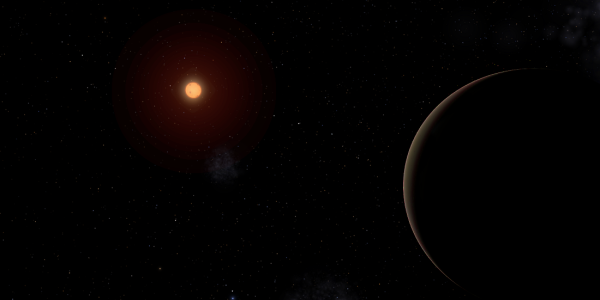 Image from The Astronomer and Steve Bowers | |
| The Resonance system, showing the red dwarf star (a.k.a TRAPPIST-1) | |
Note; the sophont arkship known as The Maid subsequently became the progenitor of a large and varied population of sophonts generally known as The Maids, many of whom remained in the Resonance system; while others became increasingly sophisticated starships travelling throughout the Terragen Sphere.
The Resonance System, also known as the Seven Marbles or TRAPPIST-1 System - Data Panel | |
| System | Resonance, a.k.a Seven Marbles |
|---|---|
| Primary | TRAPPIST-1 |
| Location | - Distance from Iota: 10.466 ly (J2000) - Distance from Sol: 40.541 ly (J2000) (Inner Sphere) - Constellation Aquarius |
| Star | Resonance (TRAPPIST-1) Physical characteristics: - Mass: 1.770E+29 kg (0.089 x Sol) - Radius: 84,180 km (0.121 x Sol) - Luminosity: 0.000522 x Sol (bolometric) - Temperature: 2,511 Kelvin - Spectral type: M8V - Age: 7.6 billion years --------------- Resonance illuminates the Seven Marbles, seven terrestrial worlds in relatively close orbits. It is a solitary late M-type main-sequence star near the lower stellar mass limit. Despite being around 7.6 billion years old, the star rotates quickly, completing one revolution in just 3.3 Terran days, but the star does not currently produce frequent nor particularly strong flares. Large starspots are common and can cause subtle temperature changes on the planets. Resonance is surrounded by seven roughly Earth-sized planets linked in a near-resonance chain and an outer asteroid belt. See more details about the subsequent history of the star Resonance in this article |
Senrau | |
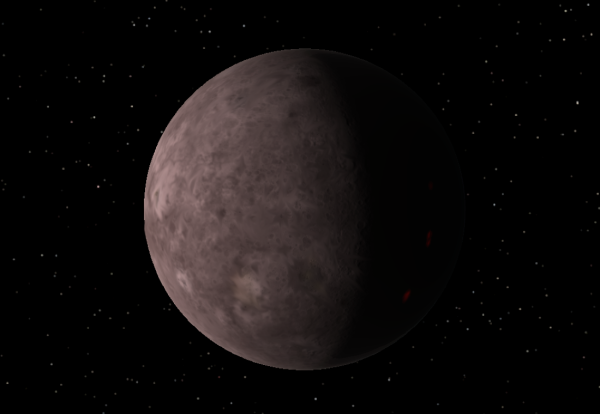 Image from Steve Bowers | |
| Senrau is a tidally-locked dry world with almost no atmosphere and a very low albedo. | |
| TRAPPIST 1b | Name: Senrau: Orbital characteristics: - Semi-major axis: 1,728,000 km (0.011 AU) - Orbital period: 1.511 days Physical characteristics: - Type: Vesperian, Videntian/Apnean. - Mass: 1.374 x mass of Earth - Radius: 1.116 x radius of Earth, 7110 km - Density: 5,425 kg/m^3 - Gravitational acceleration: 1.102 g - Rotation period: Tidally-locked - Albedo: 0.03 - Average surface temperature: 500 K, 227 C Atmosphere: - Surface pressure: 2 KPa - Composition: trace amounts of carbon dioxide, nitrogen, neon, and helium --------------- Senrau had lost most of its atmosphere due to tidal heating, as well as erosion by flare events and sputtering. These tidal effects caused the planet to be volcanically active and the lithosphere thin, soft, and plastic. Mantle plumes - exceedingly common thanks to induction heating - melted parts of the crust, forming volcanoes that resurface the planet over time. See more details about the history of Senrau in this article here. |
|---|
Rasante | |
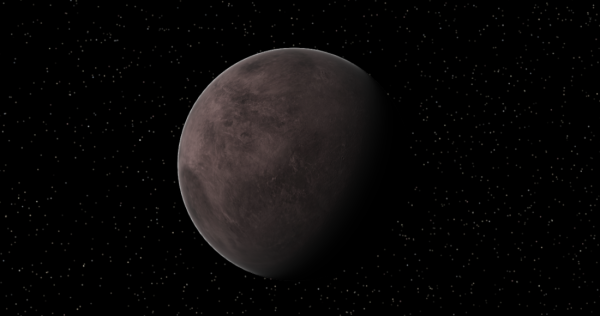 Image from Steve Bowers, from a sketch by The Astronomer | |
| Rasante, a tidally-locked world which has lost most of its primordial atmosphere. This world has since been renamed Visne. | |
| TRAPPIST 1c | Name: Rasante: later changed to Visne: Orbital characteristics: - Semi-major axis: 2,366,000 km (0.016 AU) - Orbital period: 2.422 days Physical characteristics: - Type: Vesperian, Videntian/Apnean. - Mass: 1.308 x mass of Earth - Radius: 1.097 x radius of Earth, 6988 km - Density: 5,447 kg/m^3 - Gravitational acceleration: 1.086 g - Rotation period: Tidally-locked - Albedo: 0.682 - Average surface temperature: 380 K, 107 C Atmosphere: - Surface pressure: 4 KPa - Composition: 72.4% carbon dioxide, 18% oxygen, 8.2% water, 1.4% nitrogen, trace amounts of hydrogen, methane, sulfur dioxide, argon, helium, ammonia, neon, and nitric acid --------------- By the time probes reached this system, Rasante had lost most of its atmosphere due to erosion by flare events and sputtering during the early, active stage of the star's history. See more details about the history of Rasante/Visne in this article here. |
|---|
Reyvik | |
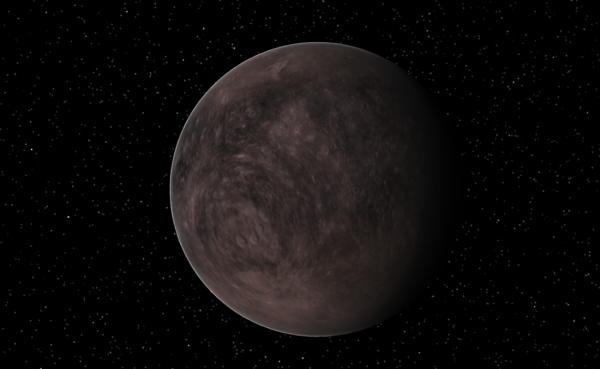 Image from Steve Bowers, from a sketch by The Astronomer | |
| Reyvik is a nearly airless, tidally-locked world like Rasante, but somewhat smaller | |
| TRAPPIST 1d | Name: Reyvik: Orbital characteristics: - Semi-major axis: 3,333,000 km (0.022 AU) - Orbital period: 4.050 days Physical characteristics: - Type: Vesperian, Videntian/Apnean. - Mass: 0.388 x mass of Earth - Radius: 0.788 x radius of Earth, 5020 km - Density: 4,354 kg/m^3 - Gravitational acceleration: 0.624 g - Rotation period: Tidally-locked - Albedo: 0.819 - Average surface temperature: 286 K, 13 C Atmosphere: - Surface pressure: 5 KPa - Composition: 30.6% carbon dioxide, 66% nitrogen, the rest hydrogen, methane, argon, ammonia, nitric acid, and neon. --------------- Like Rasante, Reyvik lost most of its primordial atmosphere due to intense flaring activity when the star was younger. See more details about the history of Reyvik in this article here. |
|---|
Fulno | |
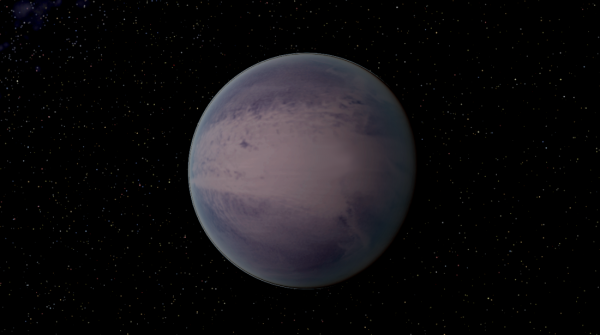 Image from Steve Bowers, cloud texture by Trolligi | |
| Fulno had a relatively thick atmosphere over a water ocean, with persistent winds that form a distinctive cloud pattern beneath the subsolar point. | |
| TRAPPIST 1e | Name: Fulno: This world has since been renamed Remi. Orbital characteristics: - Semi-major axis: 4,381,000 km (0.029 AU) - Orbital period: 6.099 days Physical characteristics: - Type: Vesperian Rhean AquaGaian (Conlectic Glacial) - Mass: 0.692 x mass of Earth - Radius: 0.92 x radius of Earth, 5861 km - Density: 4,885 kg/m^3 - Gravitational acceleration: 0.817 g - Rotation period: Tidally-locked - Albedo: 0.264 - Average surface temperature: 296 K, 23 C Atmosphere: - Surface pressure: 70 kPa - Composition: 91.4% nitrogen, 5.6% carbon dioxide (vapor), 2.9% argon, 0.1% oxygen, trace amounts of water (vapor), neon, carbon monoxide, and helium. --------------- As a tidally-locked terrestrial planet, Fulno was split into the warm dayside and the frigid nightside. Nearly the entirety of the nightside was covered in an ice cap that stored much of Fulno's water. The relatively rapid sidereal rotation of this planet (once every 9.2 standard days) resulted in a persistent wind pattern which carried warm air into the dark hemisphere and cooler, moist air to the starward hemisphere. This created a water ocean and a distinctive cloud formation on the sunlight side. The orientation of this planet 'flips' on a timescale of hundreds of millions of years, so the icy hemisphere changes location periodically. Despite the presence of water this world was found to be lifeless. See more details about the history of Fulno/Remi in this article here. |
|---|
Eunna | |
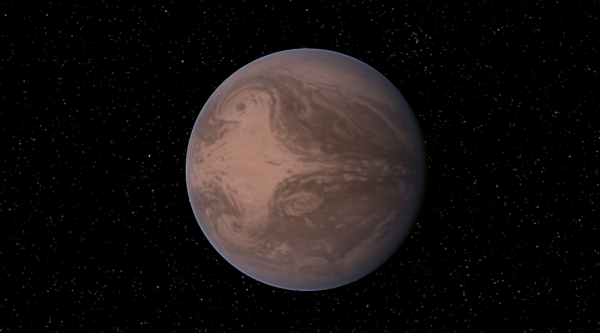 Image from Steve Bowers, from a sketch by The Astronomer | |
| Eunna is a moist world slightly larger than Earth. | |
| TRAPPIST 1f | Name: Eunna: this world has since been renamed Shinoh. Orbital characteristics: - Semi-major axis: 5,765,000 km (0.039 AU) - Orbital period: 9.206 days Physical characteristics: - Type: Vesperian Rhean Aquathallassic - Mass: 1.039 x mass Earth - Radius: 1.045 x radius Earth, 6657 km - Density: 5,009 kg/m^3 - Gravitational acceleration: 0.951 g - Rotation period: Tidally-locked - Albedo: 0.217 - Average surface temperature: 287 K, 14 C Atmosphere: - Surface pressure: 193 kPa - Composition: 96.6% nitrogen, 3.1% carbon dioxide (vapor), 0.2% oxygen, 0.1% argon, 0.1% water (vapor), trace amounts of ammonia (vapor), methane, neon, hydrogen cyanide, helium, carbon monoxide, and hydrogen --------------- Eunna had a cold water ocean on its dayside, while ice sheets formed at the nightside. Abiotic organic molecules were also present, but no life. Oceanic currents and wind created by Eunna's rotation animated the ocean, the ice cap, and the atmosphere. The equator region was constantly in motion as the strong equatorial current dragged icebergs across the circumference, while the glacier sheets at middle latitudes were more stable. The colder temperatures on Eunna and the calmer winds encouraged organic particles to trickle down from the sky, in a phenomenon called tholin snow. Eunna also 'flips' periodically on a timescale of tens of millions of years. See more details about the history of Eunna/Shinoh in this article here. |
|---|
Matow | |
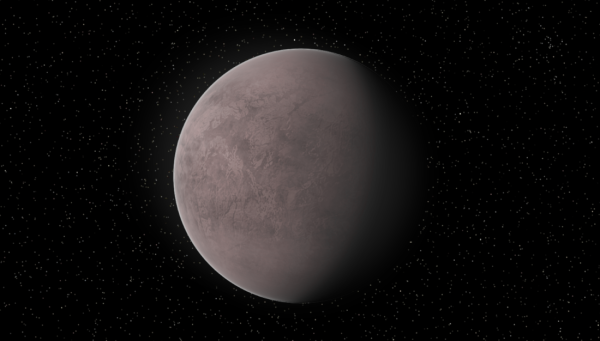 Image from Steve Bowers, from a sketch by The Astronomer | |
| Matow is a cold world, with a hazy atmosphere and a distinctive pattern of cracks. | |
| TRAPPIST 1g | Name: Matow:this world has since been renamed Nene. Orbital characteristics: - Semi-major axis: 7,013,000 km (0.022 AU) - Orbital period: 12.354 days Physical characteristics: - Type: Vesperian Tholian Rhean CapnoArean (Tundral) + AquaGanymedean - Mass: 1.321 x mass of Earth - Radius: 1.129 x radius of Earth - Density: 5,042 kg/m^3 - Gravitational acceleration: 1.035 g - Rotation period: Tidally-locked - Albedo: 0.221 - Average surface temperature: 223 K Atmosphere: - Surface pressure: 19 kPa - Composition: 98.5% nitrogen, 1.2% carbon dioxide (vapor), 0.2% argon, 0.1% carbon monoxide, trace amounts of oxygen, methane, neon, hydrogen, helium, and ammonia (vapor). --------------- Matow had a completely frozen surface, covered in water ice and traces of tholins. Its ice shell varied in thickness. On the dayside, the crust was as thin as a few kilometers, while on the nightside it was usually tens of kilometers thick. Matow experienced the strongest tidal stressing of all seven inner planets, serving to fracture the icy crust. Convection within the subsurface ocean dragged plates around, creating plate tectonics, which resulted in a large number of rifts, faults, mountain ranges, and most spectacularly, cryovolcanoes. Matow's tectonic activities were most prominent on the dayside, while the nightside, although somewhat less active, possessed the glacial equivalent of supercontinent cycles, each cycle lasting between a few centuries and millennia. Similar to Eunna, tholin snow occured on Matow's nightside. See more details about the history of Matow/Nene in this article here. |
|---|
Yaudel | |
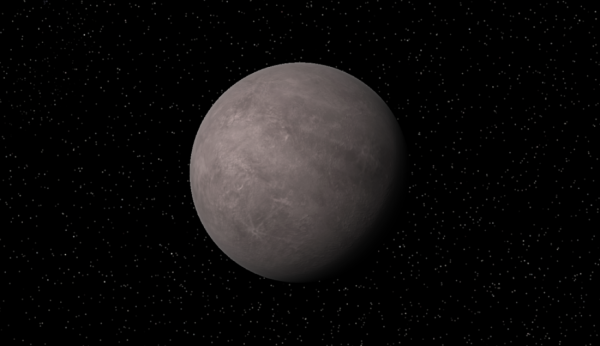 Image from Steve Bowers, from a sketch by The Astronomer | |
| Yaudel is a cold world which has several prominent impact craters | |
| TRAPPIST 1h | Name: Yaudel: Orbital characteristics: - Semi-major axis: 9,265,000 km (0.062 AU) - Orbital period: 18.768 days Physical characteristics: - Type: Vesperian Rhean CapnoChionian (Tundral) + AquaGanymedean - Mass: 0.326 x mass of Earth - Radius: 0.755 x radius of Earth, 4810 km - Density: 4,147 kg/m^3 - Gravitational acceleration: 0.57 g - Rotation period: Tidally-locked - Albedo: 0.259 - Average surface temperature: 161 K Atmosphere: - Surface pressure: 14.7 kPa - Composition: 98.1% nitrogen, 1% argon, 0.7% carbon monoxide, 0.2% carbon dioxide (vapor), 0.1% neon, trace amounts of methane (vapor), hydrogen, oxygen, and ammonia (vapor) --------------- Yaudel was a smaller and colder version of Matow, although these two factors set it apart from the bigger planet. Its tholin haze was thin enough that features on the surface could be observed in visible light, although slightly blurred. Unlike its bigger sibling, Yaudel's ice shell was thick and stagnant, with few fractures mainly caused by tidal stressing and impacts. Low internal heat meant that its subsurface ocean was not nearly as active as Matow's, further discouraging any sort of tectonic activity. The atmosphere on Yaudel was cold enough that nearly all carbon dioxide was locked in glaciers in night side lowlands and basins. Being even colder and with calmer winds, haze precipitated at the night side. Tholin dust storms fueled by subliming glaciers were a common phenomenon on Yaudel capable of depositing organic particles on the dayside, giving the planet a light brown colour. See more details about the history of Yaudel in this article here. |
|---|
| Asteroid zone | The Resonantine Belt: Total mass: 4.727E20 kg --------------- Much of the remaining asteroidal mass that survived the system's old age can be found in orbits outside the seven main worlds The largest asteroids are no more than a hundred kilometer in diameter; the largest is known as Samsara. Most asteroids in this region are carbonaceous with large fractions of volatiles, becoming more common further from the star, while some siliceous asteroids orbit closer to the star. Comets are rare. See more details about the history of The Resonantine Belt in this article here. |
|---|
Related Articles
Appears in Topics
Development Notes
Text by The Astronomer, Dangerous Safety
Updated by Steve Bowers Oct 2023
Initially published on 03 June 2020.
Cloud texture for Fulno by Trolligi, derived from this paper
Cloud Behaviour on Tidally Locked Rocky Planets from Global High-resolution Modeling
https://arxiv.org/abs/2306.12186
Updated by Steve Bowers Oct 2023
Initially published on 03 June 2020.
Cloud texture for Fulno by Trolligi, derived from this paper
Cloud Behaviour on Tidally Locked Rocky Planets from Global High-resolution Modeling
https://arxiv.org/abs/2306.12186
Additional Information
http://www.trappist.one/
The official website of the Trappist-1 star system, created by the astronomers currently studying it.
---------------





